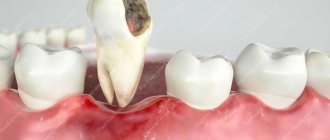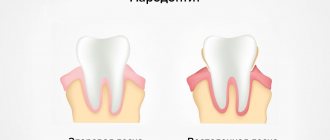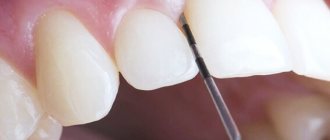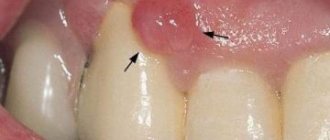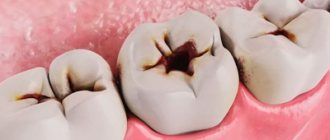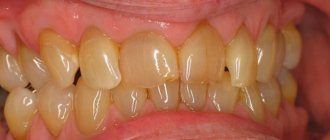September 27, 2017
Flux or periostitis (this is its medical name) is a disease in which pus accumulates around the tooth root. An abscess is very dangerous due to its complications, including the spread of pus throughout the body. Therefore, you need to not miss the onset of the disease and try to see a doctor for help as early as possible. And in no case should you self-medicate, as this can speed up the transition of the disease from one stage to another.
Flux on the gum
UltraSmile portal . ru reminds you that periostitis is a very dangerous disease! We have selected several photos of flux that clearly demonstrate all the dynamics of the development of the inflammatory process.
Causes of the disease
Patients often blame the careless work of dentists for the development of inflammatory processes in the oral cavity. Thus, “flux after wisdom tooth removal” is one of the most discussed topics on dental forums. In fact, the most common causes of periostitis are gum trauma and untreated tooth decay. Often the situation is complicated by the patient’s reluctance to visit the dentist in a timely manner. As a result, food debris inevitably accumulates in places of damage, which eventually begin to rot. Further, the pus accumulates and then begins to rapidly spread, affecting healthy tissues of the oral cavity.
The most common causes of gumboil are damage to the gums, poor oral hygiene and caries.
Treatment of flux on the gums with folk remedies cannot guarantee a high-quality result. Most often, self-prepared medicinal products can only suppress the pronounced manifestations of the disease, and not eliminate the causes of its occurrence. For this reason, when the first symptoms of periostitis appear, it is important to undergo high-quality flux treatment in dentistry, which can guarantee complete relief of the inflammatory process.
First aid at home
Unfortunately, toothache in adults, like gumboil, occurs at the most inopportune moment, when it is not possible to see a doctor in the near future and solve this problem using traditional methods (we recommend reading: what is the fastest way to get rid of toothache at home?) . You have to resort to various remedies prepared according to traditional medicine recipes to help with gumboil, relieve unbearable pain and wait for an appointment with the dentist. You should not take painkillers or drink alcohol, as the latter reduces the effectiveness of the drugs.
How to rinse your mouth?
The simplest, but at the same time effective recipe for rinsing is a salt-soda solution (we recommend reading: how to prepare a soda solution for rinsing the mouth?). It is simple and quick to do in any conditions. Salt has an anti-inflammatory effect, prevents the formation of pus, and soda is an alkali and has bactericidal properties. If you add a couple of drops of iodine, the effect will increase. If possible, it is better to rinse your mouth with a solution of Furacilin, Miramistin or Chlorhexidine (more details in the article: is it possible to rinse your mouth often with chlorhexidine).
Herbal infusions
How to rinse your mouth with dental flux (we recommend reading: how to quickly remove swelling with dental flux)? Herbal decoctions also provide excellent relief from the condition. To get rid of the flux, you should use herbs such as plantain, calendula, chamomile, coltsfoot, sage and others. To prepare the medicine in the form of a decoction, you will need one part of dry herb and five parts of boiling water. Pour boiling water over the dry raw materials, then leave on low heat for 10-15 minutes. Leave and strain. You can take any herb, or even better, combine several types of herbs.
Apply compresses
You can remove pus from a tumor on the gum with a compress of steamed cabbage leaves. To do this, pour boiling water over a cabbage leaf or a small piece of it, the water will cool slightly, the leaf will soften, then you need to tear off a piece of the required size and apply it to the sore spot. You can also use cotton wool soaked in propolis tincture as a compress. Propolis is infused with alcohol or vodka and relieves pain well, but this remedy can burn the mucous membranes. A carnation flower or a piece of cut aloe leaf has also proven effective in treating flux at home.
Folk remedies
There are a huge number of traditional methods for treating periostitis at home. The simplest and most convenient of them are the following:
- Carefully wrap half a teaspoon of soda in a small piece of bandage and apply it as a compress between the cheek and the inflamed gum. The saliva will soak the bandage, and in the meantime the soda will slowly melt, gradually revealing its beneficial properties. This method is very effective - it makes it possible to remove swelling in 1 day.
- Compress made from cotton wool soaked in freshly squeezed onion juice. It is useful to mix the juice with honey. This will sweeten the bitter medicine a little and add beneficial microelements.
- A compress made from an infusion of sage and mustard plaster is effective. Moisten a cotton swab or a piece of bandage folded several times in the warm infusion, then apply to the sore spot.
- “Dead” water or brine for rinsing will help draw out the pus. To do this, a large spoonful of salt must be dissolved in a glass of warm boiled water.
Symptoms of gumboil
Symptoms are expressed in the appearance of a purulent sac or thickening of the gum area. The photo shows a clear example of gumboil on the gum. It is this infiltrate that is the main sign of the development of the disease. Experts distinguish two main forms of periostitis:
- The acute form is accompanied by severe toothache, severe tissue swelling, and swelling of the cheek. As the disease develops in the lower jaw, inflammation of the lymph nodes and swelling of the chin may occur. Often the advanced form of the disease causes elevated body temperature.
- The chronic form of the disease proceeds slowly and imperceptibly, which is its insidiousness. Often there is thickening of the jaw bone in the affected area. Despite the fact that there are practically no pronounced symptoms in this case, the consequences of this form of flux are no less dangerous.
general description
Periostitis (flux) (K10.2) is an inflammation of the periosteum of the tooth, manifested by severe pain and swelling of the gums.
Causes:
- Unsanitized teeth.
- Infected wounds of the soft tissues of the face, open fractures of the jaw.
- Hematogenous and/or lymphogenous spread of infection in tonsillitis, sinusitis.
Predisposing factors: hypothermia, ARVI, tonsillitis. Often periostitis is a complication of periodontitis, pulpitis, and the consequences of tooth extraction.
Diagnostics
Before proceeding with dental flux treatment, the doctor must conduct an appropriate diagnostic examination. The exact diagnosis is determined based on data obtained during a clinical examination and x-ray diagnosis. Laboratory tests allow you to accurately determine the stage of the inflammatory process. Only after making an accurate diagnosis will a specialist be able to decide what to do with gumboil and which method of treatment in this particular case will be optimal.
How to treat flux?
If your tooth hurts and gumboil appears on your cheek, you shouldn’t panic and look for something to rinse your mouth with. “Grandmother’s” treatment methods really help get rid of acute pain and relieve some swelling, but they have not yet helped anyone cope with purulent compaction, which is the main danger. How and with what to treat flux? How to remove gumboil in case of gum inflammation? Only a qualified dentist can give detailed answers to these and other questions.
Self-medication with folk remedies will only help dull the pain and relieve swelling a little. Only a qualified dentist can completely remove pus and eliminate the cause of inflammation.
How is flux treated in dentistry? Currently, there are two main methods of treating gumboil on the cheek:
- Opening the pus sac, in which the doctor removes the accumulated pus through a small incision. The procedure is performed under anesthesia. After removing the pus, the specialist installs a drainage at the site of the incision - a special rubber strip that ensures the outflow of pus and prevents the wound from healing ahead of time.
- Cleaning an abscess through a root canal is necessary if the inflammation is a consequence of caries or a crack in the tooth.
Often in advanced stages of the disease there is a need for tooth extraction. Typically, this procedure is carried out when there is deep destruction of the causative tooth or if there is a large infected area between the tooth and the gum. Removal is also used if there is a sufficiently large crack in the tooth that cannot be treated.
Typically, the doctor begins by making an incision into the periosteum or lining of the mouth. The causative tooth is usually removed gradually, that is, in parts. For this, a special dental saw or laser is used. Modern equipment has made it possible to make the procedure for tooth extraction quick and completely painless, so there is no need to be afraid of treatment. After the operation, the sharp edges of the incision are smoothed, which is then washed with peroxide or other antiseptic agents and fixed with sutures.
Use of ointments
Often, when treating gumboil, personally prepared ointments are used to help reduce pain and relieve inflammation. Their use has such positive aspects as safety, therapeutic effectiveness, accessibility, and multifaceted effects on the body.
- Grind dried calendula flowers . Mix with unsalted butter in a ratio of 1:5. Apply to a cotton ball and place on the sore spot overnight.
- 50 g of vegetable oil over low heat. Add 20 g of propolis to it . Wait until the entire mass acquires a homogeneous consistency. Place the container in a cool place for 3 hours (for example, in the refrigerator). Apply the resulting ointment to the site of inflammation twice a day.
- Honey-based ointments are very easy and simple to prepare at home. Place 50 g of linseed and olive oil in a container. Add 50 g beeswax and 1 tbsp. a spoonful of honey. Bring the resulting mass until the wax is completely melted, heating in a water bath. Remove mixture from heat. Add honey to it and leave to cool. Apply the prepared ointment to a cotton pad and apply to the gumboil. Leave for 1.5-2 hours.
For severe throbbing pain, soak a cotton pad in onion juice and apply it to the sore spot. Onions, being a natural antibiotic, will quickly remove unfavorable microflora and relieve inflammation and pain.
The most incredible treatment method is applying garlic to the wrist. The method has been proven for centuries, effective, although inexplicable. A paste is prepared from the garlic and spread over a gauze bandage. Apply to the wrist so that the garlic itself does not come into contact with the skin. The main thing is to apply it to the hand opposite the sore gum.
So, there are many possibilities and fairly simple ways to get rid of gumboil using traditional medicine. However, this disease is very serious and in the future, in order to avoid complications, it is necessary to consult a dentist.
Antibiotics for flux
As noted above, flux is a consequence of a bacterial infection, which is often treated by taking antibiotics. Many, at their own peril and risk, try to cope with inflammation by independently taking quite strong medications that can cause serious damage to the health of the entire body. Effective and at the same time safe treatment of flux with antibiotics can only be prescribed by a qualified specialist.
Antibiotics for flux are prescribed by a doctor individually. Self-use of strong medications is fraught with serious consequences for the entire body.
Antibiotics, like anti-inflammatory drugs, are used in dentistry for flux as part of complex maintenance therapy. The only way to stop the inflammatory process and remove the pus is surgery. Antibiotics are usually prescribed at the very beginning of treatment if the disease is in the earliest stages of its development, but identifying such inflammation at the initial stage can be quite difficult. As a rule, the dentist is able to detect the very first signs of periostitis by accident, for example, during a routine examination of the oral cavity. The specialist prescribes antibiotics for flux individually, depending on the characteristics of the patient’s body and the general clinical picture.
Acute and chronic forms
If we talk about how long periostitis lasts, we need to mention that it all depends on its form. Acute flux appears suddenly and develops rapidly. It is characterized by a strong purulent inflammatory process. The problem appears after pathogenic microflora forms in the periosteum. The disease lasts about 2-3 weeks, subject to timely consultation with a specialist and proper treatment. Read more in the article: “Acute periostitis of the jaws.”
An abscess can come out under any tooth
The chronic form takes a very long time to pass. It can last from 5 to 8 months, and with weak immunity – several years. At the same time, periostitis constantly makes itself felt with exacerbations. Chronic flux often has a strong effect on the face. The bone tissue in the area of inflammation noticeably thickens, and the lymph nodes become larger. In this case, the disease sometimes does not manifest itself in the oral mucosa.
Flux - treatment in children
If a child has flux, you should never give him medications on your own, and especially antibiotics. Only a dentist can prescribe a medicinal course of treatment. Antibiotics destroy both pathogenic and beneficial bacteria that help fight infection, so the unauthorized use of such serious drugs can lead to negative consequences for the child’s entire body.
Treatment of gumboil largely depends on the causes of its occurrence. So, this process is not much different from the treatment of periostitis in adult patients. As a rule, to begin with, the specialist makes a small incision in the area of the inflammation and ensures the outflow of pus using a special drainage system. The treatment then continues at home under the supervision of parents. Most often, a complex of medications is prescribed, but in some cases, a specialist may allow you to limit yourself to rinsing with special decoctions and solutions.
Medication options
You can also use some professional techniques at home, in particular drug therapy. First of all, this is taking a course of antibiotics .
However, it is highly undesirable to do this without consulting a doctor.
The following solutions are also suitable as a therapeutic rinse:
- Chlorophyllipt;
- Vinylin;
- Hexoral;
- Hepilor and others that have an antimicrobial effect.
You can also use crushed Furacilin tablets.
How not to cause harm?
What to do if flux appears? Some patients mistakenly believe that swelling and severe toothache can be relieved on their own with the help of warming compresses, herbal infusions and other folk remedies. Unfortunately, such health experiments often end very badly. Thus, in order not to inadvertently harm yourself and provoke further development of the disease, the following contraindications should be observed:
- No warming compresses that contribute to the spread of periostitis.
- Never take painkillers less than 3 hours before visiting the dentist. Otherwise, you can significantly complicate the diagnosis process.
- After opening a purulent lesion, you should not take aspirin. It can provoke bleeding, especially since it is completely useless as a pain reliever in this case.
- If your condition has not improved 12 hours after surgery, you should see your doctor again.
Prevention - expert advice
We figured out what to do if your cheek is swollen, and how to remove acute pathological manifestations before visiting a doctor. But it is much easier to prevent any disease than to treat it later. To prevent a purulent lump from appearing on your gum, you must follow the recommendations below:
- get into the habit of brushing your teeth at least twice a day, and even better - after every meal,
- if it is not possible to clean every time after a meal, you should thoroughly rinse your mouth with plain water or a special antiseptic, and also use dental floss,
- it makes sense to purchase an irrigator - a portable device that supplies a high-pressure stream of water and air to more effectively clean hard-to-reach places,
- you need to monitor the condition of the gum tissues, prevent their damage and bleeding,
- If you notice the first signs of caries, you should immediately see a doctor.
Don’t forget to visit your dentist’s office every six months to undergo preventive examinations and professional cleaning procedures to remove plaque and deposits. To protect yourself from dental problems, you will have to reconsider your usual diet - limit the consumption of sweets, starchy foods and carbonated drinks with dyes. Eat more fruits and vegetables, as well as foods high in calcium and fluoride.
What to do after removal or opening?
After opening the flux, you should not wait for the swelling to disappear immediately. Many patients feel that the flux does not go away after tooth extraction, although this is not the case at all. In some cases, the swelling may increase slightly after the procedure. Approximately on the third day after surgery, the patient should make a dramatic recovery, but the infiltration may remain for quite a long time. Within a few hours after the operation, the toothache in the area of the lesion should disappear and the body temperature should decrease.
Usually the swelling goes away only a few days after opening the purulent focus. Do not be alarmed if the swelling increases slightly after surgery.
The specialist installs a special rubber drainage in the incision, which you should never try to fix yourself. Otherwise, the recommendations are the same as for regular tooth extraction. You should not eat for several hours after the procedure. During the day, try to avoid hard and rough foods, as well as hot drinks. Regarding the use of medications in each individual case, the specialist gives individual recommendations.
Treatment prices
The cost of flux treatment largely depends on the severity and severity of the disease, as well as on the method of therapy chosen by the specialist. It is worth noting that modern medicine offers all the possibilities for quick, effective and completely painless elimination of the causes and consequences of periostitis. In addition, the price for flux treatment is influenced by factors such as the level of prestige of the dental clinic, the cost of the equipment and materials used, and the level of qualifications of the practitioners.


